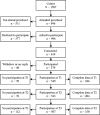Are unpopular children more likely to get sick? Longitudinal links between popularity and infectious diseases in early childhood
- PMID: 31504058
- PMCID: PMC6736236
- DOI: 10.1371/journal.pone.0222222
Are unpopular children more likely to get sick? Longitudinal links between popularity and infectious diseases in early childhood
Abstract
Social stress and inflammatory processes are strong regulators of one another. Considerable evidence shows that social threats trigger inflammatory responses that increase infection susceptibility in both humans and animals, while infectious disease triggers inflammation that in turn regulates social behaviours. However, no previous study has examined whether young children's popularity and their rate of infectious disease are associated. We investigated the longitudinal bidirectional links between children's popularity status as perceived by peers, and parent reports of a variety of infectious diseases that are common in early childhood (i.e. common cold as well as eye, ear, throat, lung and gastric infections). We used data from the 'Matter of the First Friendship Study' (MOFF), a longitudinal prospective multi-informant study, following 579 Norwegian pre-schoolers (292 girls, median age at baseline = six years) with annual assessments over a period of three years. Social network analysis was used to estimate each child's level of popularity. Cross-lagged autoregressive analyses revealed negative dose-response relations between children's popularity scores and subsequent infection (b = -0.18, CI = -0.29, -0.06, and b = -0.13, CI = -0.23, -0.03). In conclusion, the results suggest that children who are unpopular in early childhood are at increased risk of contracting infection the following year.
Conflict of interest statement
The authors have declared that no competing interests exist.
Figures




Similar articles
-
Transactional links between teacher-child relationship quality and perceived versus sociometric popularity: a three-wave longitudinal study.Child Dev. 2014 Jul-Aug;85(4):1647-62. doi: 10.1111/cdev.12216. Epub 2014 Jan 7. Child Dev. 2014. PMID: 24397289
-
Perinatal Maternal Stress and Susceptibility to Infectious Diseases in Later Childhood: An Early Life Programming Perspective.J Psychol. 2019;153(1):67-88. doi: 10.1080/00223980.2018.1483311. Epub 2018 Sep 28. J Psychol. 2019. PMID: 30265824
-
Early maternal perceived stress and children's BMI: longitudinal impact and influencing factors.BMC Public Health. 2018 Oct 30;18(1):1211. doi: 10.1186/s12889-018-6110-5. BMC Public Health. 2018. PMID: 30376822 Free PMC article.
-
Assessment of young children's social-emotional development and psychopathology: recent advances and recommendations for practice.J Child Psychol Psychiatry. 2004 Jan;45(1):109-34. doi: 10.1046/j.0021-9630.2003.00316.x. J Child Psychol Psychiatry. 2004. PMID: 14959805 Review.
-
Children with disabilities: a longitudinal study of child development and parent well-being.Monogr Soc Res Child Dev. 2001;66(3):i-viii, 1-114; discussion 115-26. Monogr Soc Res Child Dev. 2001. PMID: 11677873 Review.
Cited by
-
The mediating effect of self-efficacy in the relationship between communication skills and practices of preventing infectious diseases among daycare center teachers in South Korea.Child Health Nurs Res. 2021 Jan;27(1):56-64. doi: 10.4094/chnr.2021.27.1.56. Epub 2021 Jan 31. Child Health Nurs Res. 2021. PMID: 35004497 Free PMC article.
-
Status does not predict stress among Hadza hunter-gatherer men.Sci Rep. 2023 Jan 24;13(1):1327. doi: 10.1038/s41598-023-28119-9. Sci Rep. 2023. PMID: 36693868 Free PMC article.
-
Trajectories and predictors of vicarious traumatization in Chinese college students during the COVID-19 pandemic: A longitudinal study.Front Psychiatry. 2022 Oct 21;13:1026905. doi: 10.3389/fpsyt.2022.1026905. eCollection 2022. Front Psychiatry. 2022. PMID: 36339876 Free PMC article.
-
Increased symptoms of post-traumatic stress in school students soon after the start of the COVID-19 outbreak in China.BMC Psychiatry. 2021 Jul 3;21(1):330. doi: 10.1186/s12888-021-03339-3. BMC Psychiatry. 2021. PMID: 34217234 Free PMC article.
References
Publication types
MeSH terms
LinkOut - more resources
Full Text Sources
Medical

